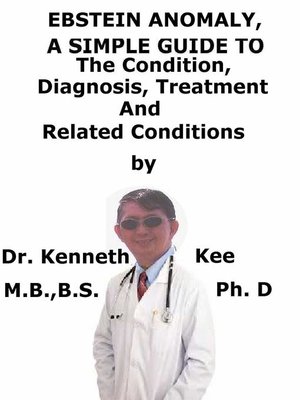Ebstein Anomaly, a Simple Guide to the Condition, Diagnosis, Treatment and Related Conditions
ebook
By Kenneth Kee

Sign up to save your library
With an OverDrive account, you can save your favorite libraries for at-a-glance information about availability. Find out more about OverDrive accounts.
Find this title in Libby, the library reading app by OverDrive.



Search for a digital library with this title
Title found at these libraries:
| Loading... |
Ebstein Anomaly is a rare congenital heart disorder in which parts of the tricuspid valve are defective.The tricuspid valve separates the right lower heart chamber (right ventricle) from the right upper heart chamber (right atrium).In Ebstein Anomaly, the positioning of the tricuspid valve and how it functions to separate the two chambers is unusual.Ebstein Anomaly is a malformation of the tricuspid valve and right ventricle typically featured by:1. Adherence of the septal and posterior leaflets to the underlying myocardium.2. Downward (apical) displacement of the functional annulus.3. Dilation of the atrialized portion of the right ventricle, with various degrees of hypertrophy and thinning of the wall.4. Redundancy, fenestrations and tethering of the anterior leaflet.5. Dilation of the right atrioventricular junction.In persons with Ebstein anomaly, the leaflets are positioned deeper into the right ventricle instead of the normal position.The leaflets are often bigger than normal.The defect most often induces the valve to work poorly, and blood may go the wrong way.Instead of flowing out to the lungs, the blood returns back into the right atrium.The backup of blood flow can result in heart enlargement and fluid buildup in the body.There may be narrowing of the valve that leads into the lungs (pulmonary valve).In many instances, patients also have atrial septal defect (a hole in the wall that separates the heart's two upper chambers) and blood flow across the hole cause oxygen-poor blood to go to the body.This can produce cyanosis, a blue tint to the skin caused by oxygen-poor blood.Ebstein anomaly happens as a baby forms in the womb.Studies have shown both genetic and environmental risk factors:The anomaly is more frequent in twins and in those with a family history of congenital heart disorder.Environmental factors found in studies are maternal exposure to benzodiazepines (tranquillizers).Maternal lithium therapy (for depression) can infrequently result in Ebstein anomaly in the baby.SymptomsSymptoms vary from mild to very severe.Symptoms form soon after birth, and are bluish-colored lips and nails due to low blood oxygen levels.In severe cases, the baby seems to be very sick and has difficulty breathing.In mild cases, the involved person may be asymptomatic for many years.Symptoms in older children may be:1. Cough2. Failure to grow3. Fatigue4. Rapid breathing5. Shortness of breath6. Very fast heartbeatOther Symptoms are:1. Cyanosis: frequent in children and often because of linked atrial right-to-left shunt and severe heart failure.In adult life, cyanosis increasingly become worse.2. Fatigue and dyspnea: because of right ventricular failure3. Palpitations and sudden cardiac death: because of paroxysmal supra-ventricular tachycardia or fatal ventricular arrhythmias.Signs:Heart sounds: the first heart sound is widely split with a loud tricuspid part.The pan-systolic murmur of tricuspid regurgitation is optimally heard at the lower left parasternal areaSigns of right heart failure: ankle edema, hepatomegaly and ascitesDiagnosis:1. Fetal life: diagnosed incidentally by echocardiography.2. Neonatal life and infancy: manifests with cyanosis and severe heart failure3. Adult life: right heart failureEchocardiogram permits definitive diagnosis.Non-surgical treatment:Medicines to help with heart failureOxygen and breathing supportAntibiotic prophylaxisTreatment of heart failure and arrhythmiasSurgery:Tricuspid valve repair is favored over valve replacement.Bioprosthetic valves are favored over mechanical prosthetic valvesHeart transplant is last resort.TABLE OF CONTENTIntroductionChapter 1 Ebstein AnomalyChapter 2 CausesChapter 3 SymptomsChapter 4 DiagnosisChapter 5 TreatmentChapter...






